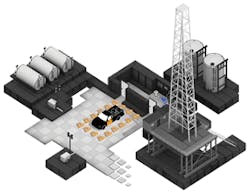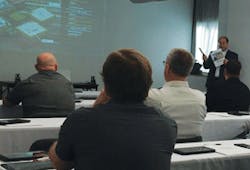The Oil and Gas Industry Takes a Progressive Approach to Safety Training
The modern recipe for vocational training begins with partnerships between industry, education and workforce development. However, it's the right application of technology that provides the secret ingredient in delivering training to meet the individual learning styles of students across a wide range of learning, language and reading skills. In turn, qualified workers are prepared to meet the skilled labor needs of industry and the trades.
This is exactly what is happening at the Energy Innovation Center (EIC) in Pittsburgh, which began operations late in 2014 at the former home of Connelley Trade School. Founded by Robert Meeder, Ph.D., president of Pittsburgh Gateways Corp., the Energy Innovation Center acquired the 6.7 acre campus located in downtown Pittsburgh in 2011. Its mission: To contribute to socially responsible workforce development, foster energy and sustainable technologies advancement, assist in job creation through a commitment to diversity, innovation and comprehensive education across the entire spectrum of the energy industry.
An important part of its mission includes providing workforce development training for at-risk populations, including women, minorities, veterans and disenfranchised young adults, and it sources workforce development for employers. Central to the effort of "dragging instructor-led training into the 21st century," a phrase repeated by several people interviewed for this article, is the creation of a learning curriculum based on emerging technologies. United Academy, the training arm of United Rentals, and Serious Labs Inc., a simulator and game-based industrial training developer, are partnering in the creation of curriculum for the EIC. The curriculum makes use of gaming, simulation, short-form video and mobile methods that are wrapped up in adaptable and measurable content.
One of the workforce training programs developed by the EIC is called the Energy Safety Passport, which is designed to standardize basic worker safety awareness and competencies in the upstream energy industry.
"The concept for the Energy Safety Passport began with energy producers working together to standardize safety and environment training," said Rich DiClaudio, an EIC founding board member and officer.
DiClaudio also is EIC's director of corporate workforce development. The Energy Safety Passport program is designed to streamline site access approvals for workers, vendors and subcontractors.
21st Century Training
"Not everyone can comprehend information in the same way," said Jim Dorris, vice president of environmental, health and safety for United Rentals. "Blended learning transcends those disparities and bridges the generational divide between baby boomers still in the workforce and incoming millennial workers."
This is a concept United Rentals has been deploying at United Academy for several years.
"There's inherent risk associated with the products we rent, whether in the transportation, operation or application," said Dorris, adding that safety is a core value at United Rentals. The organization follows the principle that it has a moral duty to offer its customers and the industry at large training that could reduce that risk.
"There's a reason why video games and virtual reality are so prominent in our society. It's complete immersion in an environmental experience that can't be replicated except in real life," he said. But real life in heavy industry, such as oil and gas production, comes with inherent risk, so immersive environmental instruction provides a risk-free way for workers to learn.
Introducing current technology in learning allows various interactions with the material, and also provides new methods of assessing students while keeping them engaged. Because instructors can assess competency along the way, teaching becomes more effective, he said.
"With the right tools, it becomes possible to teach complex concepts in a simple way," added Dorris.
Prior to partnering with United Rentals, United Academy and Serious Labs, the EIC spent about five months meeting with HSE leaders from within the oil and gas community. The challenge was creating training that meets the needs of a diverse population: individuals with graduate level education, individuals who have no formal secondary education, individuals who speak English as a second language and to provide a common jumping off point for all producers/contractors in the region.
"We knew from the beginning that our approach to learning was a very good way to address all of these diverse people in an efficient way," said DiClaudio. "Mixed media learning has a proven track record for being effective and demonstrates strong metrics for student retention of information. This led to our partnership with United Academy and Serious Labs, which has established expertise in this area."
A New Take on General Orientation
The first course to be rolled out is a general orientation (GO) course that harmonizes basic safety, health and environmental rules most energy producers require for gaining access to the various sites. Rigorous content has been developed subject matter experts from the oil and gas industry.
"There are 35 key rules we have amalgamated that all companies in heavy industry follow, such as proper PPE, no smoking, not texting and driving," said Jim Colvin, CEO of Serious Labs Inc. This is information that everyone needs, but nobody really likes to learn. Colvin says organizations often don't invest in quality instruction when it comes to GO material. It's simply a box to check.
Here's what it will look like: An instructor will lead the course using high-end graphics in a format that is more manipulative than a traditional slide show. As material is presented, "Teachers can isolate a learning objective, maybe zero in on worksite imagery, then pause to observe a 3D object," explained Colvin.
Students are issued tablets and throughout the instruction, games are used to drive home the learning objectives.
"In order to succeed in a multi-level game, students have to apply their knowledge correctly to the environment. This enables rote memorization of even the most pedestrian information without it being boring," said Colvin. Periodic knowledge checks give instructors feedback in real-time to assess what information has been understood and what needs review.
Getting Ready for the Next Boom
The EIC is different from other training schools because it is being driven by industry need.
"This industry-based approach develops curricula specifically for what the oil and gas producers are looking for," said Jeff Snyder, Serious Labs' director of operations.
"This is an opportunity for an industry to create its own standards and elevate safety collectively," Dorris added.
"We are listening to industry, finding out what needs to be done or done better or is being done well elsewhere but not in our area. Then we are deciding the best way to develop that training," said Charlie Schliebs, a founding board member of the EIC.
"It must be in close collaboration with industry in order to develop what's needed for immediate or very near-term employment opportunities for students," DiClaudio said. "Pittsburgh wasn't prepared during the previous energy boom. Skilled workers came from elsewhere in the country to fill the labor needs. A downcycle provides a chance for the region to reset and build the labor infrastructure so that during the next up cycle, local people will get the jobs."
In the first 12 months, EIC expects 4,000 to 7,000 students to complete the GO Course.
"When the oil and gas industry rebounds, as early as 2017, we expect to average 10,000 to 15,000 students per year," explained DiClaudio.
Meanwhile, there are other related business sectors looking to invest in the region, such as ethane cracker plants and natural gas utilities, which will require safety training to be developed for their particular operations.
"It's important to not overstate our progress," said DiClaudio. "We have a long way to go to hit our stride. If we are running a marathon, we are at about the first mile marker. Over time, some programs will no longer be needed or new programs will need to be created to assist the individual worker along his or her career path."
Tracy Bennett is a writer and owner of Mighty Mo Media Partners, a public relations, media strategy, and event planning company. With 20 years B-to-B publishing experience, she honed her technical expertise with crane and lifting equipment applications in construction and heavy industrial markets. Contact her at [email protected].



